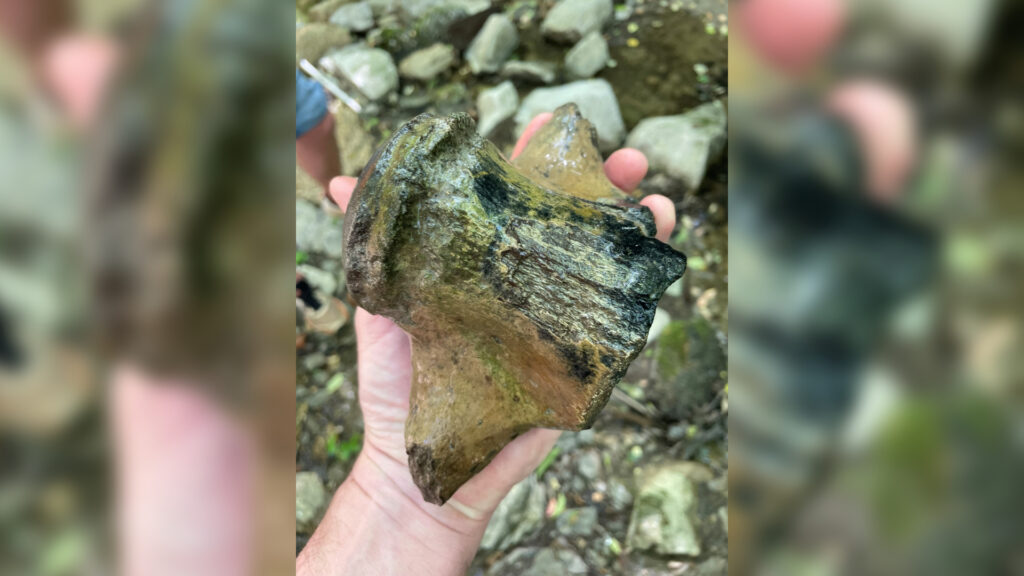
A giant “sea dragon” backbone plucked from a riverbank in Mississippi could belong to the largest mosasaur ever found in the state, scientists say.
Researchers only found a single vertebra from the creature and aren’t sure exactly how large the mosasaur was in total, but it is estimated to have been at least 30 feet (9 meters) long, Hattiesburg American reported.
Mosasaurs, or “sea dragons,” ruled the oceans when dinosaurs dominated the land towards the end of the Cretaceous period (145 million to 66 million years ago). The newly discovered fossil belonged to Mosasaurus hoffmanni, which was one of the largest — if not the largest — mosasaur species.
James Starnes, a geologist at the Mississippi Department of Environmental Quality, spotted the fossil protruding from a stream bed just south of Starkville on April 15, he told Live Science in an email. His fellow geologist, Jonathan Leard, then carefully pulled it out of the sediment.
“I immediately knew what it was, but was completely awe struck by its size,” Starnes said. “The feeling you get when you find a fossil, even as a professional, never gets old. But when you find something you have never seen before, the elation can be overwhelming.”
Related: ‘Red flags’ raised over ancient sea monster pulled from Moroccan mine
Mosasaurs were a diverse group of marine reptiles. Researchers are still figuring out the sizes of the largest mosasaur species, but they likely reached a maximum length of around 50 feet (15 m). One of the largest specimens on record is a skull that belonged to M. hoffmanni and is estimated to be around 56 feet (17 meters) long, according to a 2014 study published in the journal Proceedings of the Zoological Institute RAS.
The newly discovered vertebra fossil is more than 7 inches (18 centimeters) wide at its widest point. Starnes and his colleagues compared the fossil to the largest mosasaur remains held in the Mississippi Museum of Natural Science, which include jaws, portions of a skull and a tooth. Starnes noted that the jaws and skull appeared to be from a smaller individual than the individual represented by the new vertebra, but the tooth looked like it belonged to an individual that was more comparable in size to the new specimen. In other words, the new fossil seemed to belong to a mosasaur that was bigger or as big as the largest in the state museum. Starnes noted it could be the largest in the state’s history.
“It may represent the largest,” Starnes said. “The lumbar vertebra we found is a good indicator to the relative size of the animal. This is the biggest one that I have ever encountered.”
M. hoffmanni was an apex predator, hunting down prey with large jaws and cone-shaped teeth. Large mosasaurs likely ate whatever they wanted for the most part, including fish, sharks, sea birds and even other mosasaurs — researchers have found the remains of mosasaurs in the fossilized stomachs of other mosasaurs. The giant mosasaur that left behind this particulare vertebra likely had no shortage of food in what is now Mississippi, which had a very different environment towards the end of the Cretaceous.
“Mississippi was completely covered at the time by warm shallow tropical sea that was teaming with life, including a wide diversity of sharks, fish, marine lizards, and ammonites,” Starnes said. “Pterosaurs and even some birds would have been flying overhead while a variety of both plant and meat-eating dinosaurs of different sizes and kinds would have been walking the shore lines and through the wooded forests along the coastal estuaries.”
As well as being one of the largest, M. hoffmanni was also one of the last mosasaurs. The group went extinct alongside non-avian dinosaurs after the Chicxulub asteroid slammed into Earth 66 million years ago. The rich marine ecosystems that mosasaurs depended on collapsed following the strike, bringing the reign of this dominant ocean predator to a permanent end.
